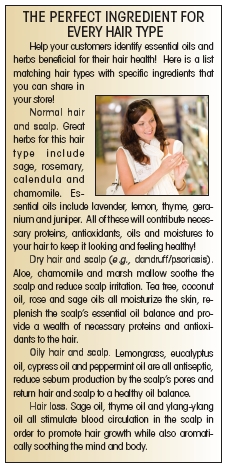What makes the difference between natural shampoos and conditioners and those fortified with synthetic components? The ingredients, of course! Synthetic agents in traditional shampoos and conditioners are designed to mimic the desirable cleansing and conditioning properties of ingredients found organically in nature. This month’s HBC Counter profiles a few select ingredients often found in natural shampoos and conditioners. These profiles compare natural compounds to their synthetic counterparts, so you can accurately respond to client questions and generate interest in your store’s natural shampoos and conditioners.
Cleansers with Organic and Natural Ingredients
When dissecting a shampoo label for your customers, identify ingredients such as soapwort, sage oil, castile oil or glycerin soap as naturally occurring soaps. Soapwort (saponaria officinalis) is a perennial herb that creates a lather in water when agitated. Sage oil is astringent, antiseptic, cleansing and stimulates blood circulation. Castile soap is a mild soap derived from olive oil, and glycerin soap is an effective cleanser and moisturizer.
The most popular synthetic detergents are sodium lauryl/laureth sulfate, both of which are non-degradable, potentially allergenic compounds that are easily absorbed by the skin and do not rinse off the skin easily. These compounds oftentimes disrupt the natural balance of fatty acids, moisture and amino acids on the scalp and hair (1). Naturally occurring cleansers result in nontoxic soapy wash water after use that is comparatively safer to flush into waterways and are gentler on skin and hair.
Gentle Moisturizers
Coconut oil is frequently found in conditioners for a few reasons. First, it is a natural emollient. Emollients inhibit the loss of moisture and soften the skin, scalp and hair and are a necessary component of shampoos and conditioners. Many cold-pressed vegetable oils work as great moisturizers, such as jojoba oil, olive oil and sunflower oil. Second, coconut oil restores the natural pH level of the skin altered by soaps as well as replaces natural skin oil removed by detergents and salts (2).
Synthetic emollients include petroleumbased mineral oils (which contain carcinogens), silicones, and fatty alcohols such as cetyl and cetearyl alcohols. Each of these synthetic emollients has been shown to cause allergies, dermatitis and contact eczema in certain individuals (3). Coconut oil is a safe, gentle and cooling moisturizer perfect for sensitive, inflamed skin conditions. Coconut oil, cedarwood oil, chamomile oil and tea tree oil are all perfect solutions for dandruff as well.
Essential Oils
The nutrients, proteins and antioxidants in essential oils give hair the nourishment it needs for rich and healthful growth. Hair and scalp conditions vary from client to client so particular ingredients will be more beneficial depending on the client’s needs (see side bar for specific recommendations). However, generally therapeutic ingredients to flag for your customers are the essential oils ylang-ylang oil, cedarwood oil, rosemary oil and chamomile oil. Ylang-ylang oil is great for promoting hair growth; cedarwood oil has antiseptic properties and is beneficial for hair growth and dandruff treatment; rosemary oil improves circulation and cleans the hair and scalp; and chamomile oil is perfect for treating dry, sensitive skin (3). Also, these essential oils are naturally fragrant and can replace synthetic perfumes and fragrances, which sometimes cause skin irritation and allergic reactions in certain individuals (1).
Biodegradable Surfactants
Surfactants lower the surface tension between the many ingredients in hair care products and allow the product to spread more easily. Natural surfactants are derived from soapwort, yucca and quillaya plants. These surfactants are biodegradable and commit less damage to the water supply when washed down drains.
Sodium lauryl/laureth sulfate is a popular surfactant found in many shampoos and conditioners. Synthetic detergent polyethylene glycol is on the FDA’s list of suspected carcinogens and synthetic surfactant compounds including DEA, MEA, TEA or MIPA may form nitrosamines, which have been determined to cause cancer (3). WF
References
1. M.M. Eby, Return to Beautiful Skin: Your Guide to Truly Effective Nontoxic Skin Care (Basic Health Publications, Laguna Beach, CA, 2008).
2. B. Fife, C.N., N.D., The Coconut Oil Miracle (Penguin Group, New York, NY, 2004).
3. M.B. Janssen, Naturally Healthy Hair: Herbal Treatments and Daily Care for Fabulous Hair (StoreyBooks, North Adams, MA, 1999).
Published in WholeFoods Magazine, January 2011









